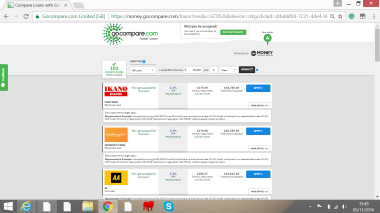Price comparison websites (PWCs) have recently emerged from the boom in online purchasing. These websites are the digital version of a single market, because they display information about lots of different firms/ suppliers in one place for consumers to look at. Although the theoretical market structure of perfect competition has often been referred to as an ‘unattainable Utopia’, many economists have reviewed the market of PWCs as the closest to this concept. These websites are said to benefit consumers by increasing competitive pricing pressure on firms by fully informing shoppers with prices of competing firms.
 By using the example of GoCompare.com, we can see how easily consumers can navigate their way through quotes for money loans from various websites. The screenshot shows that the web-page holds details for 103 different firms for the exact same service but at different prices – and even ranks these according to their own criteria. We can assume that the information on this website is fully correct, so this fits the characteristic of perfect information and the scale of firms which perfect competition requires. I set the search engine to a specific criteria to make sure the services are homogenous, but each result came back slightly different – perhaps suggesting a movement away from completely perfect competition.
By using the example of GoCompare.com, we can see how easily consumers can navigate their way through quotes for money loans from various websites. The screenshot shows that the web-page holds details for 103 different firms for the exact same service but at different prices – and even ranks these according to their own criteria. We can assume that the information on this website is fully correct, so this fits the characteristic of perfect information and the scale of firms which perfect competition requires. I set the search engine to a specific criteria to make sure the services are homogenous, but each result came back slightly different – perhaps suggesting a movement away from completely perfect competition.
Because the results are all differentiated by price on this website, any price rise is sure to behave elastically and lose the firm consumers – hence why the suppliers are supposedly price takers. This is in line with the perfect competition attribute which dictates that none of the firms are in a monopoly/ dominant position so must accept the market price. The advantage of perfect competition in this instance would allow the consumers to enjoy the lowest possible price for the same good.
The main argument against price comparison websites enabling perfect competition is the additional cost that firms incur by joining the website. This cost is enough to deter some firms from joining, which means there is a barrier to entry within the market. This attribute means that consumers may not be fully informed of various options because the better firm didn’t have access to/ couldn’t afford to pay the admission fee for the price comparison website.
Another point would be that although the PWCs may not publish incorrect data, they could leave some information out that would potentially deter a consumer from certain firms if they were initially aware of this – for example, the fact that a loan company has a bad credit history or lacks experience in the market. Assuming consumers aim to maximise their own welfare, they are likely to go for the lowest cost offered but if they are not being presented with all of the information (asymmetric information) then this acts against the economic assumption.
Lastly, when presented with the full market for price comparison websites, a consumer will probably go to the most advertised or well-known one because it may appear more reliable, which presents imperfect competition even before getting onto a PWC. This would mean the market consists of a few major PWCs, like ‘GoCompare’ or ‘MoneySupermarket’ which incurs a skew of market share and causes barriers to entry from the outset.
All of these imperfections when closely analysed, move price comparison websites in practice further and further away from the concept of absolutely perfect competition.
written by Rachel Stanley
picture from Go Compare

Very true
LikeLike
Thank you, interesting piece to write 🙂
LikeLike